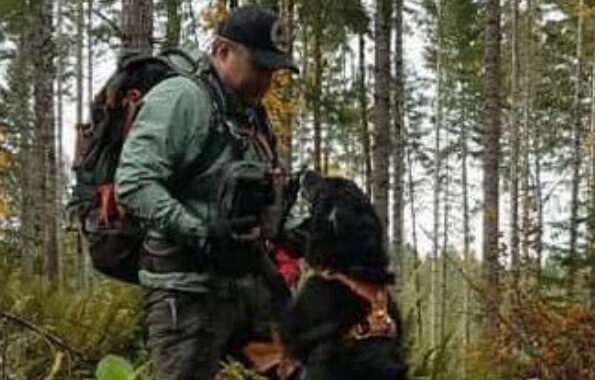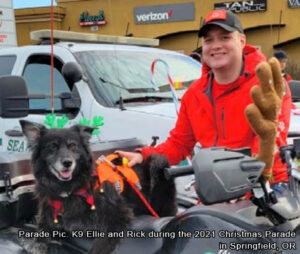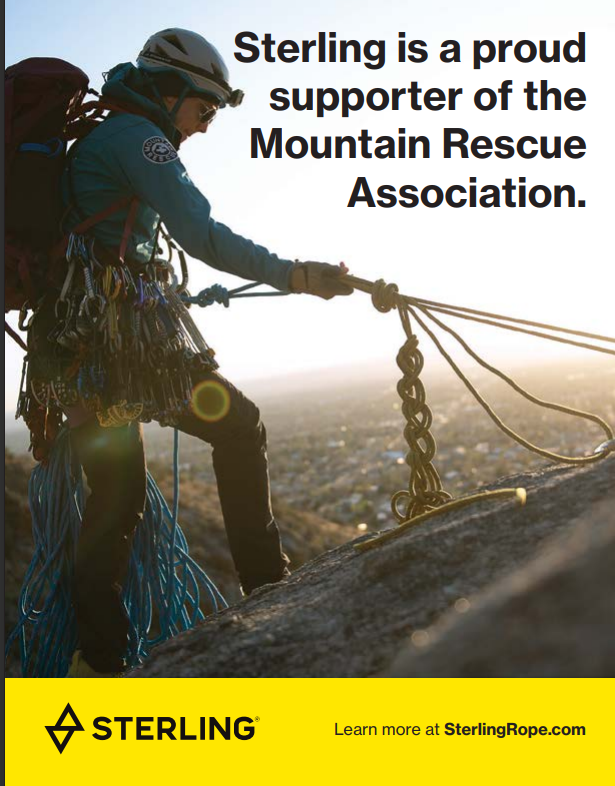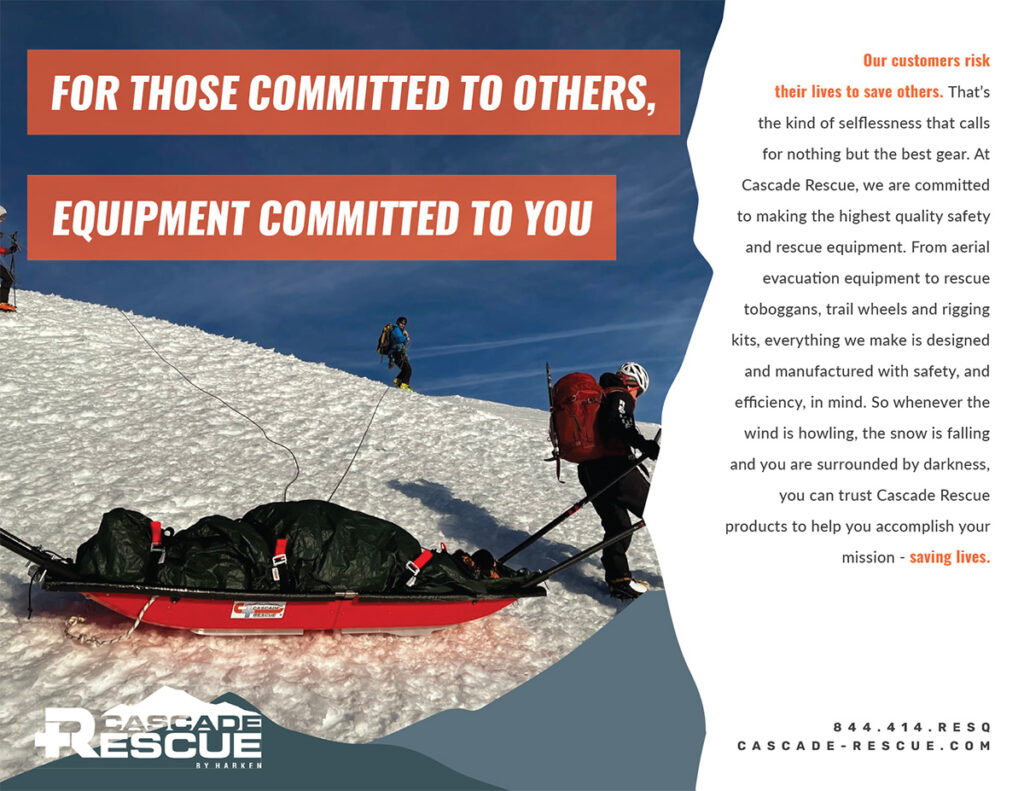Rick Lindfors – Meridian Editor in Chief
At the start of the year 2022, my dog and I tested and received our certifications for search and rescue in Oregon. Training a search and rescue K9 was a unique, demanding and ultimately formative challenge for the both of us that brought us closer together and opened up a very enjoyable avenue of SAR service for me. K9 training is a time-intensive affair, and I took it on just a few months before pandemic restrictions kicked in. Fortunately, K9 training is something that can be done in small groups outside. This is my journey in a nutshell. The steps were simple, but the journey certainly wasn’t easy.
Step 1. Dog
Many people are surprised that there’s a short list of dogs that aren’t good candidates for search and rescue. The ideal dog for backcountry search and rescue is a pooch that is smart, athletic and has a drive to work. That can cover most working, herding, and sporting breeds. There are some obvious breeds that aren’t up to the task, like pugs. Of course, it comes down to the individual dog but as far as ideal breeds go, the list of good candidates is expansive. My K9, Ellie, is a border collie/newfoundland mix. That’s a pretty rad combination when you think about it; the super smart herding breed combined with the big bear dog that has a history of water rescue. I adopted Ellie from the Greenhill Humane Society in Eugene, Oregon before I started volunteering for SAR. When I first got involved in SAR, I was working overnight as a TV news producer so my schedule wasn’t conducive to much outside of work, mountain rescue and family commitments. At the time, I didn’t think much of K9 training and wouldn’t until four years later when I got promoted and moved to a different shift.
Step 2. Talk to your K9 Team
By 2019, I had done several training exercises where K9’s had been part of the scenarios and also run some missions encountering K9 teams from assisting agencies. The discipline had caught my interest and I figured why not check it out? I contacted the president of the K9 team and she gave me a personal demonstration on how she and her trailing dog worked together, and had a conversation about the various disciplines of SAR K9 work including trailing, airscent and human remains detection.
Step 3. Start Training with your K9 Team
After applying and getting into the K9 team, I started training with them and going to team meetings. Training involved following handlers in their scenarios as well as hiding for their dogs. When following the handlers, I paid attention to how they were interacting with their dogs during various stages of a search. Each handler does things a little differently with their dogs. One team for airscent may use different alerts when finding their subject, and each dog has different preferences for their reward. Reward is a huge factor in continued success for a K9 team; if the dog is having a fun time, then they’re more likely to keep wanting to train for that reward outcome. For K9 Ellie, ball is life and cookies are great. Some dogs like their tug toys and others scarf down a bag of chicken after finding someone.
Step 4. Start Training your K9
After going through a specified amount of training with the K9 team, I received approval to start training Ellie. We began with simple drills where she found someone at short range that she also saw hide from her. With those drills she learned that finding someone and bringing me to them earned her a reward. The distance of these drills increased over time. We progressed to searching small areas of a few acres in light terrain, then increasing the size of the area and terrain variety. We trained rain or shine and each exercise yielded new learning points. Other handlers often followed me to give me pointers on my strategy, dog interaction and pacing.
Step 5. Keep it Fun
At its core, SAR is a game for the dog. The process can be distilled down to the idea of find the person, tell the human, get the reward. At the end of the exercise, it’s all about the reward. Making the exercises and outcomes as fun as possible for Ellie ensures that she wants to keep doing the SAR game even if it’s done in tough terrain or weather. If she’s having fun and succeeding in training, the better chance we’ll succeed for our subjects. Fun is not optional – it’s required!
Steps 6-1,074. Realize your K9 knows what they’re doing, and you need to catch up with them.
The dog already knows how to find people – the human is there to help and refine things. One common issue for me was talking to my dog too much, a habit I had built while jogging with her. “Shut up and let your dog work” was a common tip through my training. I was talking to her too much thinking I was helping, but what I really needed to do was watch her and adjust to the signals she was giving off (or not giving off) and adjust my actions to her, rather than trying to force her to follow a plan from start to finish. Ellie already knows how to find things with her nose, I’m the one who needs to use my eyes and ears to help her. Over time, I figured out how to make my vocals and physical movements more deliberate, meaningful and less of a distraction for her, and to pay close attention to our movement, terrain, weather and other factors to ensure our success. I also made changes to my equipment to make sure I was squared away and eliminated things that would distract me from Ellie.
Step 1,075. Test for Certification
After about a year and a half of training evolutions and consulting with team leadership, I scheduled a test for state certifications. I met an administrator at an area in Douglas County. Before the test, I made sure to understand the area, what was included within the boundaries and the time limit for finding our hider. The area we were in presented its own challenges, as does any section of terrain. But, Ellie did her thing and we found our subject within our time limit, earning our certifications. As usual, she was very happy to see her subject and play ball with her on the way back to our trucks.
Step 1,076. Keep Training
Like all skills, K9 proficiency must be maintained to be effective. The dogs themselves have the instincts they need to do the task, but going long stretches without missions or training can result in reduced performance. The same applies to the handler. If I do nothing but rope rescue training for a few months with no K9 work in between, I’m not going to work as well as I need to with Ellie. These skills are in need of the upkeep to make sure we’re always being observant and applying the right tactics. I still make a point to try to run scenarios twice a month with Ellie.
Photos
Ellie Training – K9 Ellie and Rick during December, 2020 training in Lane County Ore.
Parade Pic. K9 Ellie and Rick during the 2021 Christmas Parade in Springfield, Ore.




